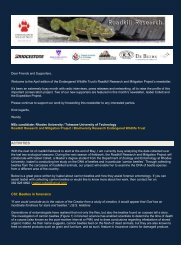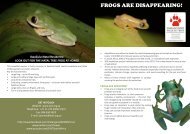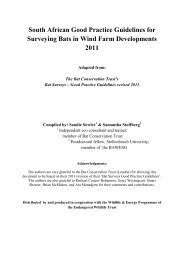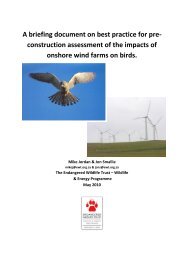click - Endangered Wildlife Trust
click - Endangered Wildlife Trust
click - Endangered Wildlife Trust
Create successful ePaper yourself
Turn your PDF publications into a flip-book with our unique Google optimized e-Paper software.
There was significant controversy regarding the potential impacts ofimmobilizations for dehorning on the reproductive rate, and specifically intercalvingintervals, in Black Rhinos in Zimbabwe during the 1990s. However, theveracity of that research has been widely questioned and more recent datafrom Zimbabwean Lowveld conservancies suggest that dehorning has noimpact on reproductive rates.Dehorning can cause damage to the horn base and deformed horn re-growthif the horn is cut too close to the germinal layer. Such problems were recordedduring the early days of dehorning in Namibia and Zimbabwe, but are nowlargely avoided by leaving a sufficient horn-layer covering the vascular tissue.An unfortunate side-effect is that a reasonable quantity of horn remains onthe animal after the dehorning process which may attract poachers. Data werecollected on estimates of the quantity of horn remaining after dehorning, butthe results are not presented due to possible security risks of divulging suchinformation.Research from Namibia in the early 1990s suggested that horn size was closelyrelated to dominance in Black Rhinos, suggesting that dehorning could havepotentially serious social consequences. However, those research findingswere based on small sample sizes (n=3), and since then, data from theZimbabwe Lowveld Conservancies have emerged which indicate thatdehorned rhinos are as likely to retain territories as horned individuals.The social and behavioural impacts of dehorning could potentially be moresignificant in small, fenced populations where rhinos occur at high densities,and particularly if the social structure is unstable due to a high turn-over ofindividuals within the population which may occur as a result of trophyhunting of animals, and live trade.Dehorning has been shown to reduce fighting-related mortalities among BlackRhinos in Zimbabwe.Research from Namibia in the early 1990s suggested that dehorning resultedin higher losses of Black Rhino calves to predation. However, those researchfindings were contentious due to small sample sizes and the possibility thatobserved trends were due to confounding factors such as intensivecompetition for food from domestic stock. Furthermore, experiences fromHwange National Park and data from Zimbabwe Lowveld conservanciessuggest that the calves of dehorned female Black Rhinos are no morevulnerable to predation than those of horned rhinos.In general, dehorning is only likely to be considered under conditions of severepoaching, under which consideration of potential veterinary, behavioural orecological problems associated with dehorning is likely to be secondary to theimperative of keeping the rhinos alive.Further research is urgently required, with cooperation of private rhinoowners, to gain empirical data on the efficacy of rhino dehorning as a meansof reducing poaching threat, and on potential impacts on social behaviour andreproductive output.Similarly, research is required to better understand poacher behaviour and thedrivers thereof to identify the extent to which dehorning is likely to act as ameaningful deterrent.Report on the impacts of dehorning5 | P a g e
















